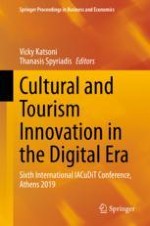2020 | OriginalPaper | Chapter
Small Towns, Cultural Heritage, … Good and Evil Queens
Authors : Angela Besana, Annamaria Esposito, Maria Cristina Vannini
Published in: Cultural and Tourism Innovation in the Digital Era
Publisher: Springer International Publishing
Activate our intelligent search to find suitable subject content or patents.
Select sections of text to find matching patents with Artificial Intelligence. powered by
Select sections of text to find additional relevant content using AI-assisted search. powered by
